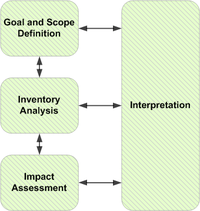
Photo from wikipedia
ABSTRACT This work deals with the application of a Life Cycle Assessment approach for evaluating the environmental and energy impacts ascribed to the production of photovoltaic (PV) cells of first… Click to show full abstract
ABSTRACT This work deals with the application of a Life Cycle Assessment approach for evaluating the environmental and energy impacts ascribed to the production of photovoltaic (PV) cells of first and second generations. PV technologies based on silicon and CuInSe2 (CIS) thin films were taken into account herein. PV systems prepared with amorphous silicon (a-Si) showed a low environmental impact and short energy payback time when compared to those ones obtained using crystalline silicon (c-Si). PV technologies associated with mono-crystal (mono-Si) and polycrystalline silicon (multi-Si) showed large emissions of CO2, nitrogen oxides, non-methane volatile organic compounds, particulates, and SO2 into air per square meter of PV panel processed. In addition, these technologies displayed a significant fossil fuel demand, biological oxygen demand, and global warming potential, which make them eco-unfriendly. Ribbon silicon (ribbon-Si) and CIS thin films showed intermediate impact scores, but further improvements in their production chain are needed before these devices are commercially used. The technologies examined herein were categorized in first- and second-generation technologies in order to compare their environmental impact and conversion efficiency. Much attention was also paid to the development of third-generation PV cells with improved conversion efficiencies and lower environmental impacts.
Journal Title: International Journal of Green Energy
Year Published: 2018
Link to full text (if available)
Share on Social Media: Sign Up to like & get
recommendations!